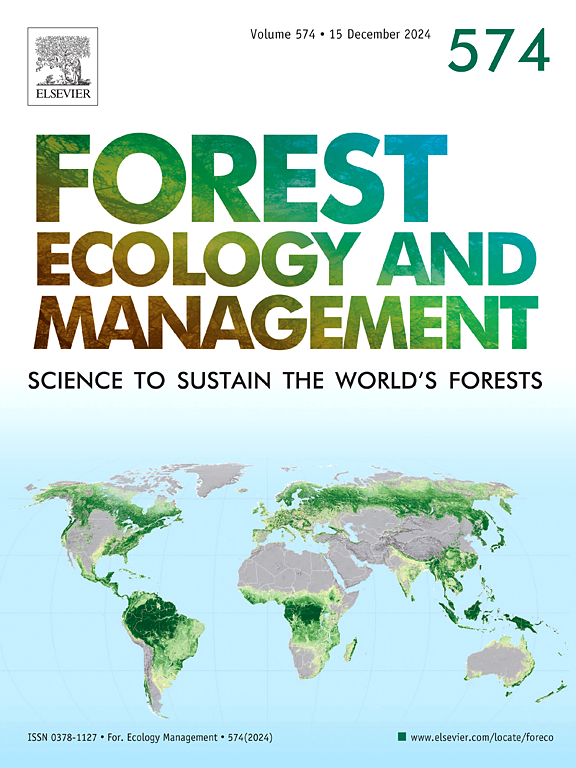Mortality of retention trees due to blowdown damage in a retention forestry experiment in Hokkaido, northern Japan
IF 3.7
2区 农林科学
Q1 FORESTRY
引用次数: 0
Abstract
Retention forestry is an approach that preserves features of the forest structure which are important for maintaining biodiversity at harvest to mitigate the negative impacts of clearcutting by retaining trees. Since these trees are exposed to rapid environmental changes upon the harvesting of the trees around them, understanding the mortality patterns is crucial so that the application of retention forestry may meet its aims. In this study, the mortality of dispersed retention trees was assessed at the retention forestry experiment sites in Hokkaido, Japan, from pre-harvest to the 6th year post-harvest. Naturally regenerated broad-leaved trees were retained at three density levels (ca. 10, 50, and 100 trees/ha) at the final cutting of a planted Abies sachalinensis forest, and all retention trees were monitored. Most dead trees were uprooted or stem-broken, suggesting that blowdown caused by typhoons and extratropical cyclones was the major cause of mortality. After harvesting, the mortality of retention trees was higher at lower retention levels, and annual mortality rates at each site were higher in the first 3 years (1.1 %–7.6 %) than from the 3rd to 6th year (0.0 %–2.6 %). Trees with smaller diameters had higher mortality rates for all species except Betula platyphylla. The form of mortality (uprooted, stem-broken, standing dead) varied among species: species with low wood density were prone to stem-breakage, whereas shade-tolerant species had a low probability of uprooting and standing dead. Species with longer longevity were less prone to uprooting and stem breakage. Stem-broken Tilia spp. trees often survived and their crowns recovered, potentially providing a tree-related microhabitat of partially dead trunks and branches. Preventing blowdown damage is important both for the management of planted forests and to ensure the presence of large old trees long after harvesting. Severe wind damage is increasing due to climate change; hence, management measures that include wind damage will become crucial in northern temperate regions including Hokkaido. In planted conifer forests, mixing of wind-resistant broad-leaved trees may increase resistance to wind damage. We recommend retaining species that are resistant to blowdown and trees with large diameters and low height-diameter ratios. Additionally, some trees may be retained in small patches to avoid individual retention trees being directly exposed to the wind.
在日本北部北海道的一项截留林试验中,截留树因吹落破坏而死亡
保留林业是一种保护森林结构特征的方法,这种特征对维持采伐时的生物多样性很重要,通过保留树木来减轻砍伐造成的负面影响。由于这些树木在周围树木被采伐时面临迅速的环境变化,因此了解死亡模式是至关重要的,这样才能使保留林的应用达到其目的。本研究在日本北海道截留林试验点,从采收前到采收后第6年,对分散截留树种的死亡率进行了评价。在萨沙林冷杉人工林最终采伐时,保留了3种密度水平(约10、50和100棵/公顷)的自然再生阔叶树,并对所有保留树进行了监测。大多数死树被连根拔起或折断了树干,这表明台风和温带气旋造成的风沙是死亡的主要原因。采伐后,保留率越低,保留率越高,每个站点的年死亡率在前3年(1.1 % - 7.6% %)高于第3至第6年(0.0 % -2.6 %)。除白桦外,直径越小的树木死亡率越高。不同树种的死亡形式(连根拔起、断茎、枯死)不同:木材密度低的树种容易发生茎断,而耐阴的树种连根拔起和枯死的概率较低。寿命较长的物种不容易连根拔起和茎断裂。断茎的椴树通常存活下来,它们的树冠也会恢复,这可能为部分死亡的树干和树枝提供了一个与树木相关的微栖息地。防止排污破坏对于人工林的管理和确保大型老树在采伐后长期存在都很重要。由于气候变化,严重的风灾正在增加;因此,在北海道等北温带地区,包括风灾在内的管理措施将变得至关重要。在人工针叶林中,混合种植抗风阔叶树可以增加对风害的抵抗力。我们建议保留抗风蚀的树种和大直径和低高径比的树木。此外,一些树木可以保留成小块,以避免个别保留树木直接暴露在风中。
本文章由计算机程序翻译,如有差异,请以英文原文为准。
求助全文
约1分钟内获得全文
求助全文
来源期刊

Forest Ecology and Management
农林科学-林学
CiteScore
7.50
自引率
10.80%
发文量
665
审稿时长
39 days
期刊介绍:
Forest Ecology and Management publishes scientific articles linking forest ecology with forest management, focusing on the application of biological, ecological and social knowledge to the management and conservation of plantations and natural forests. The scope of the journal includes all forest ecosystems of the world.
A peer-review process ensures the quality and international interest of the manuscripts accepted for publication. The journal encourages communication between scientists in disparate fields who share a common interest in ecology and forest management, bridging the gap between research workers and forest managers.
We encourage submission of papers that will have the strongest interest and value to the Journal''s international readership. Some key features of papers with strong interest include:
1. Clear connections between the ecology and management of forests;
2. Novel ideas or approaches to important challenges in forest ecology and management;
3. Studies that address a population of interest beyond the scale of single research sites, Three key points in the design of forest experiments, Forest Ecology and Management 255 (2008) 2022-2023);
4. Review Articles on timely, important topics. Authors are welcome to contact one of the editors to discuss the suitability of a potential review manuscript.
The Journal encourages proposals for special issues examining important areas of forest ecology and management. Potential guest editors should contact any of the Editors to begin discussions about topics, potential papers, and other details.
 求助内容:
求助内容: 应助结果提醒方式:
应助结果提醒方式:


